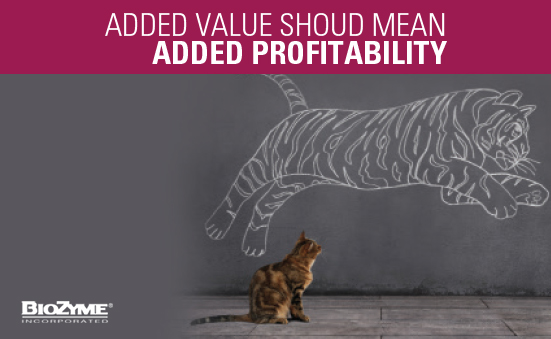Adding value is the process of changing or transforming a product from its original state to a more valuable state; from one set of characteristics to other characteristics that are more preferred in the marketplace.
Today, the “produce-then-sell” mentality of the commodity business is being replaced by the strategy of first determining what attributes consumers want in their products and then creating or manufacturing products with those qualities. Market forces have led to greater opportunities for product differentiation and added value because of:
- Increased consumer demand regarding health, nutrition and convenience;
- Efforts to improve productivity; and
- Technological advances that enable production of what consumers desire.
Adding value to products can be accomplished in a number of ways, but generally falls into two categories: innovation and coordination. One or both of these must do more than add value. To be sustainable, they must also increase profitability.
Innovation
Innovation focuses on improving existing processes, procedures, products and services or creating new ones.
Impact on profitability – sales revenue is a function of volume and price. Value-added products allow more emphasis to be placed on the price part of the equation, initially, but ultimately they will also impact the volume, thereby increasing sales revenue. Your company’s strategy should be to find sources of revenue where you can have both high volumes and good prices.
The relatively new HEAT product is a great example of value-added innovation. By adding Xtract 7065, garlic and Amaferm® we have a summer mineral that adds value by:
- Lowering heat stress so animals eat instead of standing in the shade or the ponds
- Repelling insects
- Increasing digestibility so food consumed is utilized more efficiently offsetting the negative impacts of fescue in certain areas of the country
The product is priced such that we have the profitability part of the
equation covered. In its first year, 26 tons of product was sold.
However, the added value that this product provides has impacted the volume part of the revenue equation as well; sales grew to 455 tons in 2015, and to 1,202 tons as of June 30, 2016. This value-added product has accomplished the strategy of finding a source of revenue where we can have both high volumes and good pricing for maximized sales revenue.
Coordination
Coordination focuses on arrangements among those that produce and market products. Horizontal coordination involves pooling or consolidation among individuals or companies from the same level of the food chain. An example would be hog producers combining their market hogs to make a truckload. A coordinated effort is needed to impact cost reduction.
Impact on profitability – before examining value-added processing and marketing, cost minimization must be achieved. Only efficient businesses will be able to survive and compete. Adding value cannot take the place of reaching the efficiencies attainable through technology and economies of scale.
Our mega dealers are a good example of coordination. They buy large orders and then disseminate the product out in smaller amounts at a significantly lower cost and more efficiency than an LTL company.
No matter innovation or coordination, in the end, value-added is a fairly simple concept. Create relationships with customers to encourage repeat business, improve tactics and your profits will go up.
